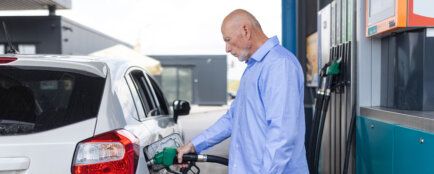In this article we explain what excise duty is, what it is paid on and how much, who is the taxpayer and who is the taxpayer, what excise duty rates apply in 2025 and how excise duty affects your everyday purchases.
What is excise duty and how does it work
Excise duty is an indirect tax included in the price of a product. Unlike income tax, the ordinary consumer does not declare or deduct it – it is paid in the price and formally paid to the government by the payer (typically the manufacturer, importer or distributor) at the time of so-called release. The legal framework in the Czech Republic consists of the Excise Act, which continuously responds to EU law and local legislative changes. The administration of excise duties is the responsibility of the Customs Administration.
Are you solving a similar problem?
Tax legal advice
Not sure how to do your taxes correctly so you don’t get it wrong? We can help you navigate the law, whether it’s dealing with a specific tax situation, preparing for an audit by the tax authority or defending yourself in court.
I want to help
- When you order, you know what you will get and how much it will cost.
- We handle everything online or in person at one of our 6 offices.
- We handle 8 out of 10 requests within 2 working days.
- We have specialists for every field of law.
Subject of excise duty
The subject of excise duty is selected products (mineral oils, alcohol, beer, wine and intermediate products, tobacco products, etc.). The products enter taxable circulation, inter alia, by being removed from the tax warehouse or sold to the final customer, at which point the tax must be declared and paid. In 2025, excise duty applies in particular to:
- Fuel – petrol, diesel. Here, the tax is levied on volume (litre, tonne etc.) and together with VAT forms a significant part of the price at the pump.
- Alcohol – alcohol (spirits), beer and wine/intermediates are taxed separately. Each group has its own rate structure (for alcohol on pure alcohol, for beer by grade and hectolitres, for wine differently for still and sparkling wines).
- Tobacco products – cigarettes, cigars, smoking tobacco, heated tobacco products, nicotine sachets and e-cigarette refills. For cigarettes, it is a combination of fixed and percentage rates with a minimum per 1,000 units. Separate rates exist for alternatives.
Why excise duty exists and what its functions are
Excise duty has three main functions:
- to fill the budget with stable revenues,
- to correct the harmful effects of consumption (tobacco, alcohol, fuel) by including part of the social cost in the price,
- to harmonise rules across the EU so that selected products are traded fairly and legally.
With fixed tariffs you know that part of the price is tax regardless of the actual price of the commodity. At the same time, the state uses stamp duties, tax warehouses and transport controls to reduce evasion and counterfeiting. As a result, the higher price encourages less consumption of risky products, protects health and the environment, and provides money for public services.
Who pays excise duty: payer versus payer
In legal terminology, you will encounter two roles:
- The payer of excise duty is the one who is obliged to declare and pay the tax to the state – typically the operator of a tax warehouse, the manufacturer, the importer, or the person who puts the selected products into free tax circulation.
- In common parlance, thetaxpayer means the one who bears the tax – i.e. you as a consumer, because the tax is part of the final price. Economically, you pay it, legally, the taxpayer pays it. Excise duty is indirect and is therefore reflected in the price of the products collected.
Excise duty rates in 2025
Excise duty rates determine how much of the price of the products collected is tax. Let us now look at how the government taxes the main groups of consumer goods and how these rates translate into current purchases:
Fuel: gasoline, diesel
In 2025, the excise duty on unleaded petrol is CZK 12 840/1000 litres, i.e. CZK 12.84 per litre, and on diesel is CZK 9 950/1000 litres, i.e. CZK 9.95 per litre.
Alcohol: alcohol, beer, wine and intermediate products
- For alcohol, the tax base is per hectolitre of pure alcohol. The consolidation package has set a gradual increase, with the rate for alcohol increasing by 10% in 2025 compared to 2024. In practice, this means that excise duty on 1 litre of 40% alcohol comes out at around CZK 156.4 ( in 2024 it was around CZK 142). Half the rate then applies to grower distillation for own consumption.
- In the case of beer, the tax is calculated according to the grade and volume. The basic rate is CZK 32 per hectolitre and each full grade, with reduced rates for smaller independent breweries.
- For wine, the system is different: still wine in the Czech Republic has an excise duty rate of CZK 0/hl, while sparkling wine and wine intermediates (e.g. vermouths) have a rate of CZK 2 340 per hectolitre.
Tobacco: cigarettes, heated tobacco, e-liquids and nicotine sachets
Cigarettes are subject to a fixed amount + a percentage of the price with a minimum. Heated tobacco has a separate rate, which also increases annually, and e-cigarette refills and nicotine sachets have their own excise duty – in 2025 5 CZK/ml for refills and 0.8 CZK/gram for sachets, with further increases planned in 2026 and 2027.
How excise duty meets the average person in practice
1) Prices on the rack and in the shop
In addition to the price of the commodity, every refuelling includes excise duty and VAT at 21%, which together make up a significant part of the final price. For spirits and tobacco, the tax is often the main component of the final price.
2) A barrel of beer, wine, home-made spirits
If you order a keg of beer for a party or buy bottles of wine for an evening out, excise duty is already included. Grow-your-own spirits are half the rate in the Czech Republic .
3) Importing alcohol and cigarettes from abroad
When travelling between EU countries, private individuals are subject to limits on the amount that can be carried for their own consumption without paying excise duty in the country of consumption. Indicative maximum values apply: 800 cigarettes, 1 kg of tobacco, 10 litres of spirits, 20 litres of fortified wine (e.g. port), 90 litres of wine (max. 60 litres of sparkling wine) and 110 litres of beer. Exceeding or indications of commercial importation may lead to a tax assessment and penalties. From non-EU countries, the limits are lower (e.g. 1 litre of hard alcohol, 4 litres of wine, 16 litres of beer and 200 cigarettes), plus customs duty and VAT are dealt with.
4) E-shops outside the EU and postal shipments
For shipments from non-EU countries, the normal exemption of up to €150 does not apply for certain categories of goods such as alcohol, tobacco and tobacco products. Ordering cheap e-liquids or untaxed cartridges or tobacco from third countries can result in additional tax or seizure of the shipment.
5) Control marks and legal origin
For selected categories (especially alcohol and cigarettes), keep an eye on the control stamps (stamps) and markings. Missing stamps or obvious tampering are warning signs that the product may not be taxed or meet legal requirements.
Excise duty increase: what’s changing in the coming years
The year 2025 follows a multi-year plan to gradually increase excise duty on alcohol and tobacco products. For alcohol, the rate went up by 10% (with a view to a further increase in 2026). For tobacco, the government has gradually increased taxation on cigarettes and alternatives (heated tobacco, e-liquids, nicotine sachets), with the pace of increase faster for some categories. The objectives are twofold: budgetary and health (reducing consumption).
Summary
Excise duty is an indirect tax included in the price of selected products – fuel, alcohol and tobacco (including alternatives). Legally, it is imposed and paid to the State by the taxpayer, but economically it is borne by the consumer in the price.
In practice, the tax significantly shapes end prices at petrol stations and in shops and is reflected in everyday purchases. For imports for personal consumption within the EU, there are indicative limits (e.g. 800 cigarettes, 10 litres of spirits, 90 litres of wine); outside the EU, the limits are lower and customs duty and VAT are added; alcohol and tobacco are exempted from the small consignment exemption for consignments from third countries. Watch for control stamps (stamps) to verify legal origin. At the same time, the government plans continued tariff increases through 2026-2027, particularly on alcohol and tobacco products – with fiscal and health objectives to curb consumption.
Frequently Asked Questions
Who pays the excise duty - me or the petrol station?
The taxpayer is usually the manufacturer, importer or distributor who declares and pays the tax. You as the customer are the taxpayer because you pay the tax in the price.
Why is there zero for wine and not for beer and spirits?
It is a political and economic decision – historically determined by production and climate specificities and industry support. Still wine has long been exempt in this country, while sparkling wine and intermediate products are taxed.
How much alcohol and tobacco can I bring back from holiday?
In the EU, follow the indicative limits for personal consumption (800 cigarettes, 10 litres of spirits, 90 litres of wine, etc.). Outside the EU, the limits are lower and customs duties and VAT come into play. Be careful with postal items – alcohol and tobacco are exempt from the general exemption for small items.




